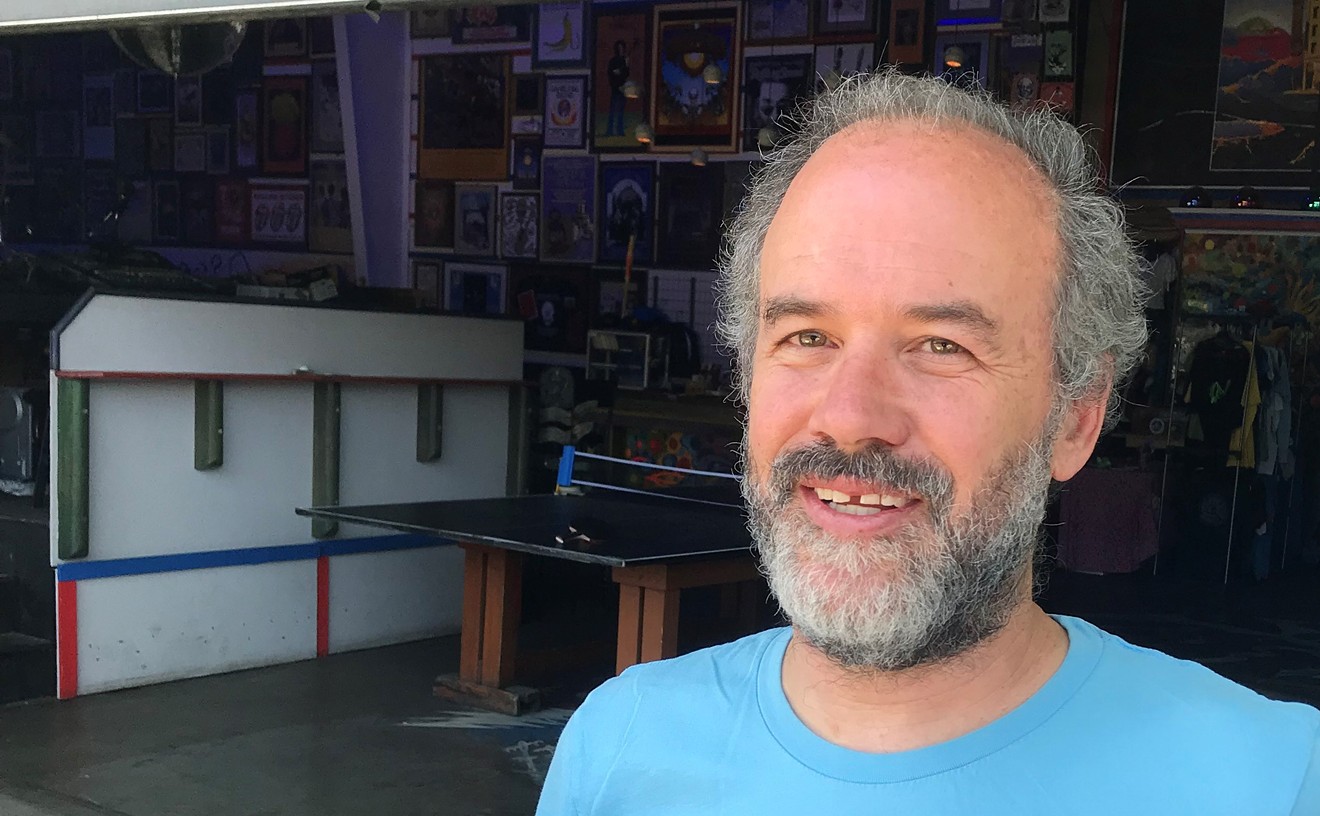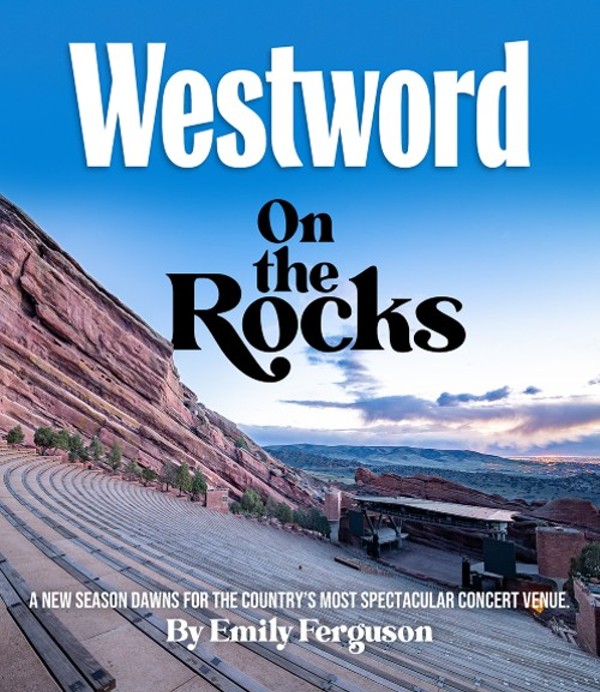This is a map of Denver in 1999, but by Tryba's reckoning it could be Paris in 1853 before Baron Haussmann remade the French capital into a city of boulevards and sidewalk cafes, or Boston in 1835 as plans were created to fill in the swamps of the Back Bay and turn the area into a cosmopolitan district of apartment buildings and shops.
Right now the Mile High City holds the same promise, Tryba insists, if only Denverites could be shaken out of their suburban sleepwalk and realize they have all the makings of a great city--an extraordinary city--right under their noses.
"It's like an empty canvas," he says, looking at the map. "I can't sleep at night, thinking about the potential of this town."
The combination of real-estate booms and busts, the leveling of historic buildings in the 1970s and the decline of the railroads have combined at the end of the twentieth century to make Denver a paradox. It's a city with a historic heart that adjoins acres of empty land, with a downtown overflowing with fashionable new restaurants and clubs that still has few residents, with inner-city neighborhoods where crack houses and half-million-dollar residences sit side by side.
And Tryba is right in the middle of it. For most of the past decade, his firm has been doing renovations in downtown Denver, including the Mercantile Square development (home of the Tattered Cover LoDo), the Hotel Teatro in the old Tramway building, Arnold Schwarzenegger's slowly progressing Stadium Walk project on Blake Street, the Euro Bath and Tile building on Market Street, and the P.S. 1 charter school in the Golden Triangle. Tryba and his staff of 26 architects have also made over several branches of the Denver Public Library, including the Park Hill, Decker, Smiley and Woodbury libraries.
Already established as one of the most historically sensitive architectural outfits in Denver, Tryba's firm now faces its greatest challenge. Suddenly most of Tryba's commissions are for new buildings, many of them in historic areas, that will help shape the look of Denver in the 21st century. Already Tryba has designed two buildings that will soon front the 16th Street Mall, and he is overseeing the mixed-use commercial district that will rise on the site of the old Cinderella City in Englewood, as well as the retail center that will serve thousands of new residents at the former Lowry Air Force base straddling Aurora and Denver.
This burst of new construction gives an architect who isn't shy about criticizing much of what's been put up in Denver since the 1950s an opportunity to show his stuff. More than anything, Tryba wants to take Denver back to the future: to re-create the pedestrian-oriented community of the early twentieth century that shopped and lived downtown, valued street life, treasured beautiful civic buildings and built an exemplary system of mass transit.
While Tryba is excited about his firm's good fortune and the ongoing revival of central Denver, he despairs over the way the metro area continues to develop. As he talks in his Capitol Hill office, the sound of bulldozers tearing up virgin prairie to the south seems to echo off the walls.
"Douglas County is the fastest-growing county in the United States," notes Tryba. "Why isn't Denver County the fastest growing? I can't imagine what it would be like to drive a half-hour every day to go to lunch and get to choose between McDonald's and Bennigan's. What does the Douglas County performing arts center look like? Do they have a major-league ballpark? Do they have a hockey team?"
Tryba's dream is to remake downtown Denver into the kind of place where tens of thousands of people live and work, where kids walk to school and people can take their families out for a night on the town without ever getting into a car. While this is a familiar lifestyle in many European cities, it's almost unknown in places like metro Denver that were built largely after World War II.
When Denver officials brag about the construction of new housing downtown, Tryba quietly fumes. "They like to boast there will be 10,000 housing units downtown," he says. "There should be 100,000 units downtown in a metro area of two million people. Why isn't that happening?"
The red smudges on the map behind Tryba's desk are the result of a brainstorming session with Denver historian Tom Noel, as the two men talked up an idea of illuminating every major historic building downtown.
This is the sort of grand plan Tryba relishes, but he often wonders if Denver can find the will to become a truly extraordinary city, one of those places where sidewalk cafes, theaters, bars, apartments and corner stores combine in a magical urban alchemy.
"Of course we can do it," says Tryba. "Whether or not we will is another question."
For a moment Tryba gazes out the window of his office, looking at the hodgepodge of high-rises and brick buildings that make up downtown Denver. His furrows his brow, and the question in his mind is clear: Can this city be saved?
Tryba is surrounded by construction all day long as crews work on restoring the 1896 Fisher Mansion at 1600 Logan Street that Tryba bought in 1997 for $725,000. He's already moved his firm there and is now converting the rest of the mansion into a home for his family.
Living in a part of north Capitol Hill that's still in transition, Tryba has been struck by the wealth of classical architecture within just a few blocks. The Cathedral of the Immaculate Conception and St. John's Episcopal Cathedral are nearby, and Tryba has counted dozens of architecturally important buildings in the blocks that radiate off East Colfax.
"You'd have to go to Washington, D.C., to see a better collection of civic buildings than we have around the State Capitol," says Tryba. "It's just incredible."
Tryba uses his new neighborhood to illustrate how different generations of architects have approached their task.
Designers once made it a priority to be good neighbors, he explains, creating buildings that were meant to fit in with their surroundings. If someone put up a new house next to a sandstone mansion, they'd be sure to include design elements that matched their neighbor. Tryba believes that sense of architectural community was lost by the middle of this century, as architects and their clients became driven by ego, trying to make every new building shout, "Look at me."
"What we've lost is the fundamental thing that builds a neighborhood, which is understanding the proportions," says Tryba. "You have to have a pair of eyes. It doesn't preclude modernism or the avant-garde. It's about understanding the rhythm and proportion of the street."
The best example of this lost design sense is in LoDo, says Tryba. Because there was hardly any new construction in LoDo in the years after WWII, the buildings in that part of Denver still reflect a turn-of-the-century ethos in which architects aimed to make their buildings jibe with whatever happened to be next door.
"Lower downtown is probably the largest number of buildings we have in Denver that are more or less contiguous," notes Tryba.
Even though LoDo contains buildings of different shapes and sizes, the area still reflects a community aesthetic. The common building materials are burnt-orange brick and stone, and building motifs such as arches, patterned brick and capstones are continued from one structure to another. This gives LoDo a stylistic coherence that's unusual in Denver.
While Tryba has probably done more LoDo renovation than any other Denver architect, he is now working on an office and residential building that will be his most prominent downtown project yet. The 16 Market Square building will break ground in a few weeks on the parking lot at the corner of 16th and Market streets.
Tryba was called in by the developer, Mark Falcone, to help redesign the project after the initial architects, Hartman-Cox of Washington, D.C., ran into trouble with LoDo's powerful Design Demolition Review Board, which must approve all new construction in the twelve-year-old historic district. The board felt that Hartman-Cox's building looked too much like a D.C. office building, and Tryba worked to reorient the project to fit in with the rest of LoDo.
With Tryba's input, the facade of the building was broken up so that it will almost look like two separate buildings. The eight-story structure also steps back on the top floors, reducing the impact on the street. The massing and patterns in the facade are similar to those of the neighboring Sugar Building at 16th and Wazee, which Tryba calls the best building in LoDo.
"David had a significant impact on 16 Market Square," says John Anderson, chairman of the design review board. "The building now has an indentation at the alley and a passageway up the alley. One part of it also steps down from the other."
Anderson says Tryba understands that among the distinguishing features of LoDo are the jagged rooflines and the way even large buildings have human-scale facades that appeal to pedestrians.
"When out-of-town architects come in here and we've beat them up about their inability to understand LoDo, we're not surprised to see them come to the second meeting with David on their team," says Anderson, a veteran Denver architect. "I think he's done the best work of any of the architects working in LoDo."
Despite his passion for historic preservation, Tryba has not simply copied nineteenth-century styles. Many of his buildings are deeply modern but still reflect a concern with context and historical precedent.
His most significant new building is Regis Jesuit High School in Arapahoe County, a project incorporating a traditional high school and a three-story chapel. The materials used are the stuff of high schools everywhere: brick, linoleum tile, concrete. But in Tryba's hands, those common materials come together to create a spiritual community in an otherwise bland suburban setting.
The blond and tan bricks used at Regis echo the tawny prairie grasses that cover the hillside location. The design of the chapel makes subtle reference to classic European cathedrals. The detailing on the roof and sides of the building allude to Notre Dame's famous flying buttresses, while skylights on the side of the nave bring a flood of otherworldly light into the chapel and mark the central worship area as sacred space.
In Tradition Hall, which links the chapel and the school, displays of trophies and ribbons note the triumphs of Regis students over the years. A simple linoleum floor is patterned in a checkerboard of mauve and gray, reflecting the school's shield. The school library faces west and is enclosed with three stories of glass that bring inside a sweeping view of the Front Range.
After seeing this building, it's not surprising to hear Tryba use a vocabulary of regeneration to describe his architectural mission.
"What we need to do is heal our built environment and provide buildings that nurture people," says Tryba. "What we've lost as a profession is our ability to see and our ability to create nurturing buildings."
Tryba's own history has shaped his approach to architecture. The 43-year-old Colorado Springs native grew up near Colorado College, in a stately old neighborhood that was laid out a century ago by the city's founders. Once known as the state's loveliest city because of its carefully planned network of grand boulevards and civic monuments, Colorado Springs has been scarred by helter-skelter development during the past thirty years. Watching his hometown's degradation has been a sad but informative experience for Tryba.
"The planning that was done in the Springs in the later part of the nineteenth century played a role in my understanding of public space," says Tryba. "There were boulevards and parkways and vistas and monuments. Now it's been destroyed."
Tryba remembers growing up in a neighborhood where children from all classes played together in the local parks. His own interest in architecture began to grow in his teenage years.
"When I was in high school, I was taking drawing classes," he recalls. "It was fun and the first thing I'd ever done that was easy for me to excel at."
As an undergraduate, he studied design at the University of Colorado in Boulder, where he took an interest in environmentally friendly construction. After graduation he backpacked around Europe before returning to Colorado and CU-Denver's graduate architecture program. He finished that program in 1980, right in the midst of the oil-driven high-rise boom, and immediately went to work for the Denver-based Gensler & Associates.
But the devastating oil-industry bust of the mid-1980s was just around the corner, and not a single building Tryba worked on at Gensler was ever built. As the local economy imploded, Tryba realized he would have to leave Colorado.
"I was thinking, 'I'm going nowhere as fast as I can,'" he remembers. "So I moved to New York City. It was fortuitous. I think there was an angel sitting on my shoulder."
In New York, where he, worked until 1988, he signed on with Beyer, Blinder, Belle. That firm is now famous for its renovations of Ellis Island and the Grand Central Terminal, and Tryba says he was plunged into an architectural milieu that was radically different from his previous experience.
"I had no love affair with historic buildings or urban design at that time," says Tryba. "I thought the purpose of architecture was to build things taller and sleeker. I was then humbled to experience an entire firm of architects that had all their egos in check."
James Fitch, one of the guiding lights at Beyer, Blinder, Belle, remembers Tryba as a brilliant designer who was quick to understand the firm's dislike of grandstanding.
"That's what some young architects find difficult to accept," says Fitch. "When doing historic renovations, you have to be able to put yourself in the shoes of the original architect. Invention is at a minimum."
The New York firm emphasized listening carefully to clients and trying to understand how a building would fit into a neighborhood. "I learned a different way of thinking about things," says Tryba. "I got an opportunity to design several mixed-use projects. I also became excited about working inside cities."
While today Tryba's heart is in downtown Denver--he estimates 75 percent of his firm's work is within walking distance of his office--he's now working on a large project that will transform the ultimate suburban monstrosity: the former Cinderella City Mall in Englewood.
The onetime shopping monolith is now being demolished, and Tryba has been given the task of converting the site into a civic and commercial center that will open up to a light-rail station now under construction. Much is riding on the project, which Englewood officials hope will trigger a renaissance for the aging suburb.
Originally, Englewood officials proposed replacing the mall with yet another "big box" collection of retail superstores. But after residents revolted, they scurried back to the drawing board and turned to celebrated planner Peter Calthorpe to help them design something better. Tryba has worked closely with Calthorpe on the project; both men are advocates of "new urbanism," the planning movement that calls for a return to pedestrian-friendly neighborhoods served by mass-transit lines.
The new scheme creates a civic and commercial district closely tied to the RTD light-rail station. Commuters will be able to step off a train and go over a bridge that Tryba hopes will resemble the famous Spanish Steps in Rome.
"You'll come down a cascading set of stairs into a beautiful urban space," says Bob Simpson, Englewood's development director. "It will have fountains and a green oval and will be an active pedestrian space with a library, stores and living areas. It will be a place where you can go to the movies, have dinner, drop off your laundry or just hang out."
The only building that will be salvaged from the old Cinderella City is the former Foley's, which will become Englewood's new town hall with a library on the first floor. A movie theater, retail stores and restaurants will be located on the plaza. Several hundred housing units will be built, and many of the retail stores will have apartments on the second floor, allowing employees to live "above the shop" and skip commuting.
The idea is to create a suburban space where it will be possible to function without a car. "We wanted to make something that would be lasting," says Simpson. "The community didn't want to see what happened to Cinderella City happen again. This will be a model for transit-oriented design here in Denver."
In 1950, the population of the entire metro area was just over 610,000, with 415,000 of those living in the city of Denver. Today 2.2 million people call metro Denver home, but only about 500,000 of them live in the city proper.
Despite this astounding growth, the things that people love about the city--the parks and parkways, the famous old hotels, the ruddy brick commercial buildings, the stone churches and government centers--were almost all created by a remarkable group of people who worked and dreamed here a hundred years ago. The fact that Denver hasn't fostered a group of city builders of equal stature since is a shame--and a challenge to those who want to guide Denver into the next century.
Three talented architects working in the 1880s and early 1890s gave Denver much of its best architecture during an extraordinary six-year building boom that lasted from 1888 to 1893. Frank Edbrooke, William Lang and Robert Roeschlaub each worked to shape the rough-hewn frontier town into a city of grace and sophistication. Their work was amplified by Denver's greatest mayor, Robert Speer, who dominated the city during the first two decades of this century and worked tirelessly to create many of Denver's parks and civic buildings, including Civic Center.
Edbrooke was summoned to Denver from Chicago--a city that greatly influenced Denver architecture--in 1879 by mining magnate Horace Tabor to supervise construction of the Tabor Grand Opera House and the Tabor Block at 16th and Larimer. (Both buildings were demolished in the urban renewal that decimated blocks of Victorian buildings in the Sixties.)
Edbrooke quickly realized that a booming Western town eager to prove itself was the perfect place for an ambitious young architect. And Denverites were quick to discover the talents of the man from Chicago, especially when they saw his buildings holding their own with those designed by firms in Boston and New York.
At one time, the 17th Street commercial district was lined with brick and stone buildings designed by Edbrooke. Most of them have been replaced by mediocre glass and steel high-rises, but several of Edbrooke's buildings still stand out in the cityscape. The Brown Palace Hotel--widely regarded as the best building in Denver--is his undisputed masterpiece, but other surviving Edbrooke buildings include the Masonic Building, the Denver Dry, the Oxford Hotel, Central Presbyterian Church, the main building at Loretto Heights and Tryba's own Fisher Mansion.
While Edbrooke focused on the commercial heart of Denver, William Lang became the city's most popular domestic architect. Dozens of his fanciful homes still dot Capitol Hill, including a remarkable set of row houses in the 1600 block of Washington Street and the Molly Brown House, at 1340 Pennsylvania Street. Lang also designed the former St. Mark's Church, at 12th and Lincoln, now the site of a popular nightclub.
Roeschlaub became known as Denver's foremost institutional architect, designing schools and churches all over the city. His existing buildings include the Dora Moore school, University Hall at the University of Denver, the Central City Opera House and Trinity Methodist Church.
While Edbrooke and Roeschlaub enjoyed long and successful careers, Lang's tragic life shows just how precarious the profession of architecture can be. After the silver crash of 1893, Lang's practice was ruined, and he began a descent into alcoholism. He left his wife and daughter in Denver in 1896 and went to live with a brother near Chicago. He was killed the next year, run over by a locomotive while walking down railroad tracks.
While each of these architects had a unique style, certain consistent design elements linked them together and helped establish a Denver style. They often used an orangish-colored brick--the color came from Colorado clay--now seen all over lower downtown. They also incorporated stone from the Rocky Mountains into many of their buildings.
The Denver aesthetic that emerged at that time, Tryba says, consisted of a palette of earth tones and a design sense that was a more modern and stripped-down version of the Chicago style. The Brown Palace is the best example of this emerging regional sensibility, he adds.
"We were really lucky, because people building at the turn of the century hired these great architects who came from Chicago and the East and stayed here because they fell in love with Denver," says Tryba.
Denver's architectural renaissance ended with the crash of 1893, part of the manic-depressive economic cycle that's shaped Denver ever since. But the design mores of that epoch persisted in Denver until WWII, and Tryba passionately believes that Denver architects need to return to those values in the 21st century.
Michael Brenneman, developer of Hotel Teatro in the former Tramway Building at 14th and Arapahoe streets, worked with Tryba and his assistant, Bill Moon, for more than a year on the $18.5 million renovation. Even though Tryba had never done a hotel before, Brenneman wanted him involved on both the building and the interior design. "We didn't want to do another chain hotel," he says. "It had to have a unique design."
The onetime headquarters for Denver's early-twentieth-century mass-transit system, the building has a marble lobby, brass elevators and molded plaster ceilings. Tryba didn't gut the interior, as many other architects do when working on historic buildings.
"There's a lot of architects that want every building to be about themselves," says Brenneman. "The building had been vacant for seven years and was badly deteriorated; the challenges were manifold. It really took a lot to restore the historic parts of the building. He did a great job."
Those who've devoted their careers to saving Denver's historic buildings say Tryba is one of just a handful of architects in Denver who really understand historic renovations. "For an architect to take on a design project where he'll be invisible at the end is a challenge," says Diane Wray, a local consultant who specializes in renovation. "David makes decisions most architects aren't capable of."
Denver planning director Jennifer Moulton, herself an architect, praises Tryba for his sense of design and willingness to take risks. But Moulton bristles at his criticism that Denver is going too slowly in trying to bring housing downtown. "Denver has been nationally recognized for developing downtown housing," says Moulton. "It doesn't happen overnight. David is very passionate and idealistic, but things don't happen that quickly."
Many factors affect the creation of downtown housing, says Moulton, including the cost of land and the ability of builders to meet demand. She points out that the cities Tryba admires took hundreds of years to develop. "Boston is 300 years old," says Moulton. "I'm not sure Denver will be like Boston in David's lifetime."
Moulton also says that Tryba underestimates the resistance of neighborhoods to increasing density. "All he has to do is go ten blocks away, and he'll find neighbors who don't want any more density," says Moulton. "It's an American dream to have land around you."
Even though he'd like to see far more development in central Denver, Tryba says the incremental pace may buffer his firm if the economy takes a dive. No one is building fifty-story high-rises, and that means architects may not be in the dire straits they encountered in the 1980s if the economy sours.
But it doesn't take an economic downturn to destroy historic landmarks.
Tryba was greatly troubled by the loss of I.M. Pei's paraboloid on the 16th Street Mall three years ago. One of the ironies of our time is that modern architecture's radical rejection of historical context has now come back to haunt it, as one modern landmark after another falls to the wrecking ball and much of the public looks on indifferently.
"How are we going to take care of the best post-war work we have?" Tryba asks. "I thought the paraboloid should have been saved. They could have turned a sow's ear into a silk purse."
For now, Tryba is busy trying to save his new neighborhood. He's working on a plan to turn the blocks around the Fisher Mansion into a historic district centered on the Immaculate Conception Cathedral. Tryba believes the city has overlooked the potential of Colfax as an urban boulevard, and he wants Denver to put as much effort into Colfax as it has into Speer Boulevard.
"Colfax's rightful place is to serve as a gathering place for two major neighborhoods," says Tryba. "The brick buildings in LoDo are nothing compared to the stone buildings in this neighborhood. We could have a half-dozen other LoDos in Denver."
Creating walkable neighborhoods means upping the density, something that Westerners have traditionally resisted. But while Americans often assume that high-density housing has to look like Manhattan, Tryba insists that central Denver could accommodate tens of thousands of new residents in five-story buildings. There's no reason, he adds, that Denver couldn't have residential districts every bit as lively as the storied neighborhoods of Paris and Vienna.
All it will take is leadership, and Tryba wonders if Denver will be up to the challenge.
"There's a leadership vacuum," he contends. "No one wants to focus on the potential. There are only a few times in the life of a city where you have the opportunity to look at what you've done and decide what the future is going to be."
As he talks, Tryba begins pacing around his office, and his voice rises in excitement.
"What makes Denver great is its smallness," says Tryba. "It's not that we have two million people and 48 local governments. It's that we're a small town that has a great performing arts center, good hotels and restaurants. We can be a walking city."
As he abruptly sits down, Tryba's gaze wanders to the cityscape just outside his window. "We have the potential," he concludes, "to be one of the greatest cities in the country."
Visit www.westword.com to read related Westword stories.










